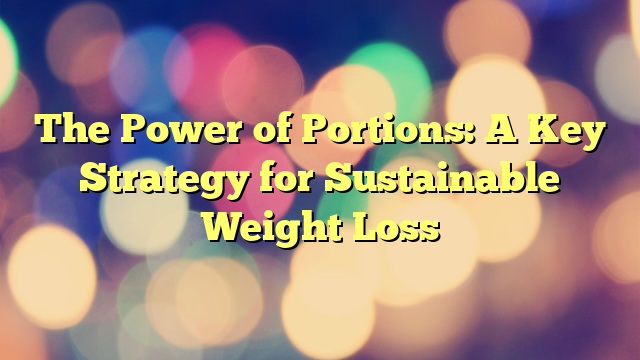The Power of Portions: A Key Strategy for Sustainable Weight Loss

In the pursuit of weight loss, many individuals often overlook the importance of portion control. However, managing your portion sizes can be a game-changer when it comes to achieving sustainable weight loss goals. Adopting this strategy not only helps you shed those extra pounds but also promotes a healthier relationship with food. In this article, we will delve into the transformative power of portions and provide practical tips to make portion control a seamless part of your daily routine.
Understanding Portion Control
Portion control refers to managing the quantity of food you consume in a meal or snack. It involves being mindful of serving sizes to ensure a balanced and nutritious diet. By regulating your portions, you can create an energy deficit, which is crucial for weight loss. However, it is essential to strike the right balance to avoid extremes such as deprivation or overeating.
Proper portion control is key to achieving weight loss goals. Here are some reasons why it is important:
-
Calorie Awareness: Controlling your portions allows you to be more conscious of the number of calories you consume. This awareness is key to creating a calorie deficit necessary for weight loss. By understanding the calorie content of different foods and portion sizes, you can make informed decisions about your meals and snacks.
-
Prevents Overeating: Large portion sizes often lead to overeating, as our body’s satiety signals may take longer to kick in. By reducing your portions, you can avoid consuming excess calories, leading to a more controlled and balanced diet. Eating smaller portions helps you feel satisfied without overindulging, promoting weight loss.
-
Optimizes Nutrient Intake: Portion control encourages you to include a variety of nutrient-rich foods in your meals. By diversifying your plate with vegetables, lean proteins, and whole grains, you ensure a well-rounded diet that supports weight loss and overall health. Each food group provides essential vitamins, minerals, and antioxidants necessary for optimal functioning of the body.
-
Enhances Metabolism: Regularly eating smaller portions can help boost your metabolism. By providing your body with a steady supply of nutrients throughout the day, your metabolism remains active, leading to more effective calorie burning. This can aid in weight loss and prevent metabolic slowdown.
-
Promotes Mindful Eating: Being mindful of your portions fosters a greater connection with your body’s hunger and fullness cues. This awareness can prevent mindless eating habits and encourage a more conscious approach to food consumption. By paying attention to portion sizes, you can enjoy your meals without feeling deprived or guilty.
Practical Tips for Implementing Portion Control
Implementing portion control into your daily routine doesn’t have to be complicated. Here are some practical tips to help you get started:
-
Measure and Weigh: Use measuring cups, spoons, and kitchen scales to accurately determine portion sizes. This is especially helpful when you are starting your portion control journey. Measuring your food allows you to have a clear understanding of the appropriate serving sizes and helps you avoid underestimating or overestimating your portions.
-
Read Food Labels: Pay attention to serving sizes mentioned on food labels. These labels provide valuable information about the nutritional content per serving, enabling you to make informed choices regarding portion sizes. Understanding the serving size can prevent you from unknowingly consuming multiple servings in one sitting.
-
Plate Composition: Aim to fill half of your plate with non-starchy vegetables like broccoli, spinach, or bell peppers. These vegetables are low in calories and high in fiber, which can help you feel full and satisfied. Divide the remaining half between lean proteins, such as chicken or fish, and whole grains like quinoa or brown rice. This balanced plate composition ensures you are getting a variety of nutrients while controlling portion sizes.
-
Pre-portion Snacks: Instead of mindlessly snacking from a large bag, portion out snacks into smaller containers or bags. This helps prevent overeating and provides a visual cue for portion control. By pre-portioning your snacks, you are less likely to consume more than you intended.
-
Listen to Your Body: Pay attention to your body’s hunger and fullness cues. Eat slowly and mindfully, allowing your brain to register when you are satisfied. Avoid the temptation to clean your plate simply because the food is there. By eating mindfully and stopping when you feel comfortably full, you can avoid overeating and maintain portion control.
-
Use Smaller Plates and Bowls: Trick your mind into feeling satisfied by using smaller plates and bowls. Research shows that we tend to consume less when our dishes appear full, even if the portion size is smaller. By downsizing your dinnerware, you can visually trick yourself into thinking you are eating more than you actually are.
-
Practice Moderation: Portion control does not mean complete deprivation. Allow yourself occasional indulgences in moderation. By savoring small portions of your favorite treats, you can satisfy cravings without derailing your weight loss progress. The key is to enjoy these treats in controlled amounts and be mindful of their impact on your overall calorie intake.
Conclusion
Portion control is a powerful strategy that can pave the way to sustainable weight loss. By being mindful of serving sizes and making conscious choices, you can create a calorie deficit, optimize nutrient intake, and prevent overeating. Implementing practical tips, such as measuring portions, reading food labels, and listening to your body’s cues, can make portion control an effortless habit. Embrace the power of portions and embark on a journey towards a healthier, fitter, and more fulfilled version of yourself.
